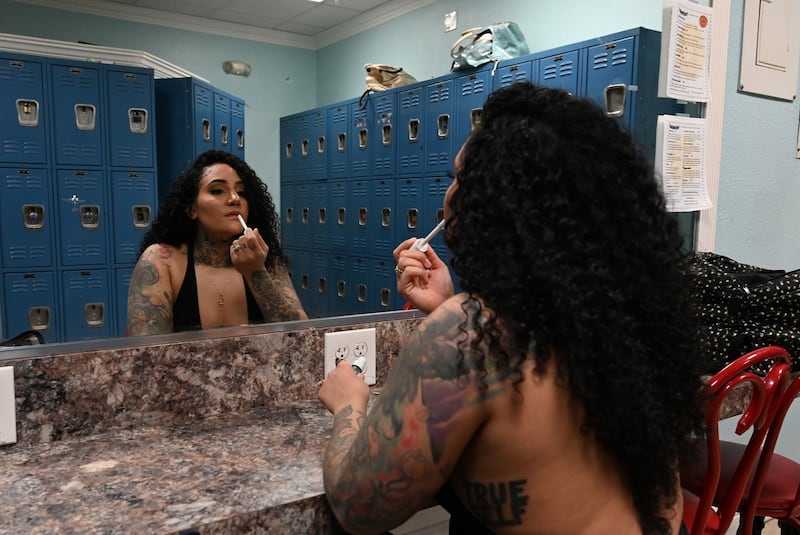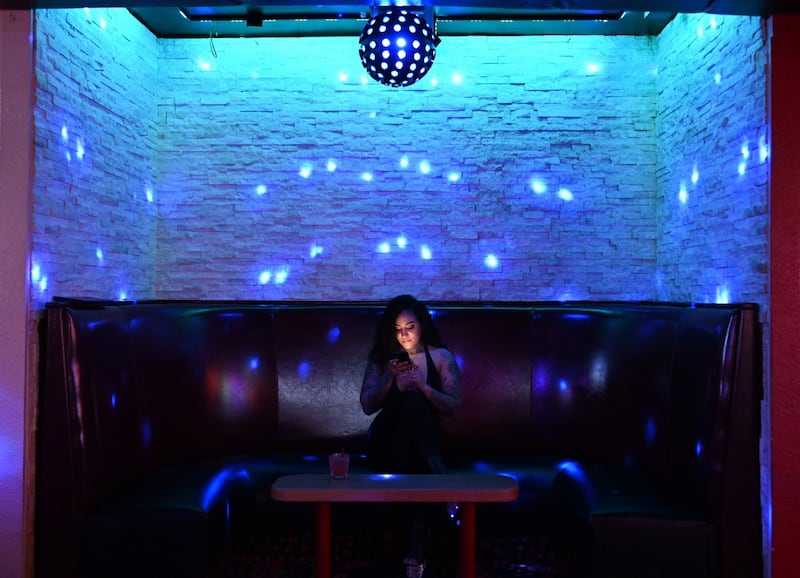Teauryajya DuBenion, who is 29, started her stripping career in Los Angeles with the encouragement of some friends. "In Los Angeles everyone is a stripper," she says. "Your local nurse is a stripper, teacher is a stripper, babysitter is a stripper, your dog walker is a stripper. I was tired of skipping meals."
Now, more than two years and 400,000 followers later, DuBenion, who goes by @PicassoBae, thinks of herself as TikTok’s stripper girlfriend. “You can just run to me in the dressing room whenever you’re having a rough night and just vent,” she says. “I’m like your coworker or work wife.”
DuBenion is part of a growing American community of strippers on the social-media platform who post under the hashtag #Striptok. Instead of gathering around a water cooler, they have built an online network to exchange professional advice, safety tips and good old-fashioned strip-club gossip.
I discovered there was an entire community of strippers on TikTok. A lot of women were sharing their experience as strippers: some were educating, others were glorifying the industry. I figured why not share my experience?
DuBenion recently made a viral TikTok advising dancers on how to strip while menstruating. She offers punchy yet practical insights, like “double up on panties.” The video had almost 500,000 views, and the comment section was a chorus of women doling out feminine-hygiene tips. “The comment section was flooded with women giving additional advice on what worked for them whether they strip or not,” DuBenion says. “It was awesome.”
She believes that many of her female followers who watch her TikTok do not aspire to be strippers but are simply inspired by her charisma and poise. “I’ve had people message to tell me that they have this newfound confidence whether they want to strip, or in their current job, or life goals they set for themselves,” she says. “All because of the way that I speak about my own life experiences through stripping.”

Another popular StripTok user is Sky Hopscotch, as she is known on social media, who on a chilly night in her home in Des Moines, Iowa, not long ago flippantly tossed supplies on to a black shimmering bag and read a checklist: lingerie, makeup, baby wipes, perfume and paracetamol. In a bored, deadpan voice, the 27-year-old delivered each line off-camera: "Who are we kidding? The men you're dancing on are going to sweat all over you too."
She uploaded this tutorial with a caption: “Is your life falling apart? Can’t pay your rent? What you should bring on your first night as an exotic dancer.” The next morning the video racked up two million views, and her account ballooned to 30,000 followers. “It was then that I started posting exclusively StripTok content,” she says.
Strip-club clients would single me out and request lap dances from me because they knew I was inexperienced. They could be more handsy, cheat me out of money or try to get me to leave the club with them
On the platform she has unearthed an audience eager to inherit her wisdom as a stripper: the good, the bad, the banality of men’s attention. “I discovered there was an entire community of strippers on TikTok,” she says. “A lot of women were sharing their experience as strippers: some were educating, others were glorifying the industry. I figured why not share my experience?”
In this enclave of the app, women show off bruises from twerking, recite locker-room melodramas, boast bill counting and lament sexual harassment. In many ways StripTok has allowed strippers to reclaim agency in their work, partly because they give advice and encouragement to one another in an industry rife with disappointment.
When she began her career, 10 years ago, Sky Hopscotch was what is commonly referred to in the stripping community as a “baby stripper”. Inexperienced strippers are even more vulnerable to harassment and exploitation at the whims of bosses and customers. “Strip-club clients would single me out and request lap dances from me because they knew I was inexperienced,” she says. “They could be more handsy, cheat me out of money or try to get me to leave the club with them.”

Many strippers on TikTok are using their platforms with the goal of helping younger dancers avoid troubling experiences. They hope that their advice will be one step in strip clubs’ becoming safer and more amicable workplaces. “It’s vital that veteran dancers share their secrets, like hiring a bouncer to go with you to bachelor parties, so new girls in the industry don’t have to get hurt,” Sky Hopscotch says.
Under the constraint of catering to male fantasy and competitiveness, strip clubs often become an oppressive environment. The toll on mental health can be considerable. “I struggled deeply with depression, drug and alcohol addiction, eating disorders – all manners of things,” Sky Hopscotch says. “If I wasn’t pretty, if I wasn’t thin, then I would not be able to pay my bills.”
If the strip club is dominated by the male gaze, then StripTok offers viewers something else: a place where strippers are free to present themselves as themselves. Many videos on StripTok feature strippers in states of casualness – without makeup, stretching in locker rooms, idle at home in sweatpants. Others are in oversize T-shirts counselling fellow strippers on how to write off hair extensions as a tax deduction.
You clock in for work at 7pm. These girls are just eating a Caesar salad, playing on their phones and talking to each other about their man troubles
Katt, a 24-year-old stripper living in Los Angeles, who asks to be identified only by her first name, found refuge in StripTok after feeling disillusioned by her job. She worries that the strip club teases out "the most toxic parts of myself that wants to be man-pleasing".
When she became active in the StripTok community, she began playfully experimenting with her own gender representation. “You see me in short hair, long hair, different wigs; different looks of makeup, no makeup,” Katt says. “I feel like people are always there, hyping me up and relating to my experience without making it about what I look like. That’s really validating to me.”
Katt, who is Asian American, says she is overly familiar with objectification, both on and off the clock. “That’s something I’ve experienced my whole life, by every kind of man,” she says. “You see yourself in the media as the hot Asian girl or the nerdy Asian girl.”
Through her online platform she recounts her experience of being bisexual and Asian in the stripping community, often spurring hundreds of positive comments and a network of support for other strippers from diverse backgrounds. Katt, who sometimes raps along to music in her TikToks, hopes that by showing the quotidian lives of strippers she will help humanise the profession. “You clock in for work at 7pm,” she says. “These girls are just eating a Caesar salad, playing on their phones and talking to each other about their man troubles.”

The interest with the interior lives of strippers on TikTok is not without precedent. "It's because of me," says A'Ziah King, known as Zola, in a message over Instagram. "I birthed an era and made a lane for sex workers to be vocal about their experiences, and I am happy that door is now open."
In 2015 King posted a long thread – 148 tweets – about a debauched weekend she spent stripping. Her posts were filled with enthralling details of betrayal, attempted murder, sex trafficking and friendship lost. The story trended worldwide within hours and was recently adapted into the film, Zola, directed by Janicza Bravo.
“I think it’s crucial for the community to share all angles and experiences within sex work, and only a sex worker can do so,” King says. “It’s important we share these experiences, because it creates a safe space and sense of community.” Despite being a reprieve from strip-club bureaucracy, TikTok, like other social-media sites, often censors strippers and sex workers. TikTok’s guidelines state that it “does not allow nudity, pornography or sexually explicit content”. Yet strippers say that informational TikToks about sexual health, safety tips and general tutorials are targeted too. DuBenion had her account banned entirely and recently created a second account. StripTok posts often disappear, accounts are shadow banned (essentially made invisible to everyone except the poster), and content is removed without explanation.
This can affect livelihoods, as some strippers rely on TikTok’s Creator Fund as a second source of income during periods of financial drought at the club. Sky Hopscotch says her account is frequently deleted after educational posts about supporting sex workers. During this time her secondary income plummets.
“I was making anywhere from $40 to $60 a day” – about €33 to €50 – “from the Creator Fund and then, the last three weeks, I’ve been making 96c a day maybe,” she says. “We have to be very careful about what we say and do on TikTok out of fear that we’ll be deplatformed.”

This censorship has spawned a mutated, hidden language on TikTok to discuss sex work. To adapt to TikTok’s policies, strippers refer to their work as “accounting” or “skripping” to camouflage themselves. “Anytime I refer to stripper, I’ll say ‘skrippa,’” DuBenion says. “Sometimes, if I write it out, I use dollar signs and an exclamation point for the ‘i’. There are things you have to finagle to make it work.”
Despite the late nights and confining heels, she still loves being a stripper. She is saving the money she earns from stripping to fund a group home for people with Down syndrome, which her sister has. “It wasn’t until recently that I started receiving donations from family, friends and even supporters across my social-media platform,” DuBenion says. “I even saved all the money I made from the TikTok Creator Fund to go toward a down payment on the house. I would never have thought that stripping, two and a half years ago, would have such a positive impact on my life and the lives around me.”
DuBenion recounts times when men have come into her strip club and handed her $100 notes because they’re moved by her acts of charity online. She hopes that this experience will encourage other strippers to tell their stories: express their own vulnerabilities and discontents.
“I just want everybody to see that I am a real-life person and that I do have purpose in this world,” she says. “I’m doing it for a good cause, and I’m relatable. I don’t know – I’m not an object.” – New York Times
















